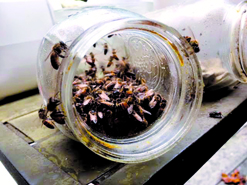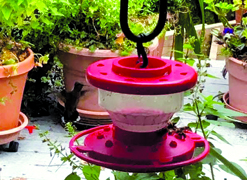Hummers v. Bees

There’s a tiny battle taking place this time of year. Honeybees are chasing hummingbirds off their sugar feeders and a number of callers have asked how to keep the bees away.
Actually, a couple callers said my honeybees are “invading” their feeders but since they live more than 5 miles away, I know it’s not my bees. That’s the bees’ maximum flying range from their hives.
The August dearth is hard on honeybees. Traditionally the time when temperatures stay above 90F for more than a week in a row, it’s also the time when plants go into survivor mode and stop producing nectar and pollen.
Bees collect nectar for the carbs to fuel flight. They use pollen as food for baby bees. They mix pollen with honey, water and enzymes, then store the “bee bread” inside a hive near where the queen is laying eggs so it is handy for nurse bees to do the feeding.
Flowers attract pollinators such as honeybees with the sweet nectar counting on bees to move pollen from one plant to another as part of the plants reproduction.
When bees don’t find food in nature, they will turn to their stored food, honey. Not a bad idea except that honey is their stored winter food and the only food they have in those cold months. If they eat all of their stores in August, it will be challenging to put enough honey away in September and October for winter supplies, which means the colony may die mid-winter from starvation.
Which is a long way to explain why bees are found in hummingbird feeders this time of year. Hummingbird food is one part sugar and four parts water, similar to a very light nectar some flowers produce. Without a better nectar source available, bees will turn to hummingbird feeders for the sugar syrup fix.
There are a couple of things that can discourage them. Place a tray with small rocks and sugar syrup away from the hummingbird feeder location and take down the hummingbird feeder. After a couple of days, the bees should be re-directed to the saucer with syrup and hummingbirds can get back to getting a sweet drink.
Here is the basic hummingbird syrup recipe. No need to add red food coloring: one part sugar to four parts water.
Use hot water to help dissolve the sugar.
Clean out the hummingbird feeder with water and good scrub. Don’t use soap. It will leave a residue in the feeder that will sour the sugar water.
I also make what I call “beerariums” out of jars lined with gravel. Lying on their sides, the jars with a dab of sugar water or leftover honey make good bee feeding stations, especially during rain. Bees can wait out a rainstorm inside the jars and still get a drink while they are waiting.
If you try to make one, make sure the side of the jar is covered with rocks to ensure the bees have a safe place to land.
Charlotte Ekker Wiggins is a beekeeper, gardener and sometimes cook. Published by El Dorado Springs Sun with author’s permission. Copyright 2018, all rights reserved. Contact Charlotte at gardeningcharlotte@gmail.com with your questions and comments.

BUSY BEES – One of my beerariums keeps my honeybees busy and away from the hummingbird feeder. Most of the time. (Photos by Charlotte Ekker Wiggins).

BEES FEED WITH HUMMERS – One of my regular hummingbirds tries to take a drink from a hummingbird feeder covered in honeybees.



Facebook Comments